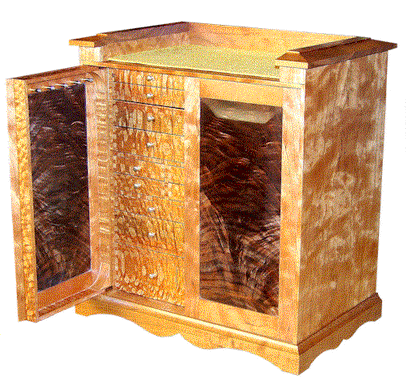 here
are hundreds of wood species available from worldwide
sources, each with unique characteristics that affect every aspect of
your work. Wood varies not just in color and grain pattern, but also
strength, weight, compatibility with adhesives and finishes, and the
ease with which it can be worked with various types of tools. It you are
a maker of Windsor chairs, there are some properties that make certain
woods easier to bend than others. If you are a luthier – a maker of
musical instruments –some species conduct sound or produce more
pleasing tones. If you build boats, certain species will fair better
when in constant contact with the water. To choose the best wood for a
project, you must understand the attributes and properties of the available species. here
are hundreds of wood species available from worldwide
sources, each with unique characteristics that affect every aspect of
your work. Wood varies not just in color and grain pattern, but also
strength, weight, compatibility with adhesives and finishes, and the
ease with which it can be worked with various types of tools. It you are
a maker of Windsor chairs, there are some properties that make certain
woods easier to bend than others. If you are a luthier – a maker of
musical instruments –some species conduct sound or produce more
pleasing tones. If you build boats, certain species will fair better
when in constant contact with the water. To choose the best wood for a
project, you must understand the attributes and properties of the available species.
Your most common choice is
a botanical distinction. Commercial lumber is commonly divided up into
two broad categories, hardwoods and softwoods. This has little to
do with their relative hardness, although as a group, hardwoods rank
harder than softwoods. Rather, it denotes a difference between lumber
sawn from trees with encased seeds and leaves versus those with cones
and needles.
For a woodworker in North
America, there are actually three types of woods — domestic hardwoods,
domestic softwoods, and imported woods or “exotics.” Most imports are
hardwoods, but we have come to think of them as a
class by themselves.
However you wish to divide them up, there are over 250 types of lumber
commercially available in the United States and perhaps as many as 1,000
worldwide. Even if you work with just a few species that are available
locally, it’s useful and exciting to know about the incredible variety
of available globally.
Contents
|
|

This jewelry chest is not just an example of fine craftsmanship.
It's also an eye-popping demonstration of how wood species can be combined to produce a stunning
visual effect.
Specs:
21" high, 18" wide, 10" deep.
Materials:
Curly Cherry, Walnut Burl, Lacewood.
Craftsman:
Jim McCann, Clayton, Ohio.
|